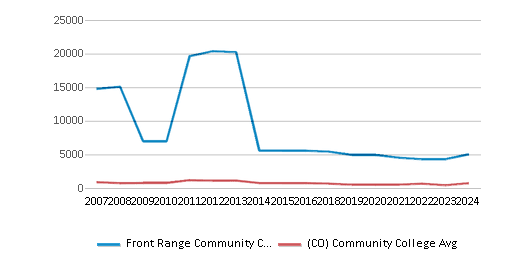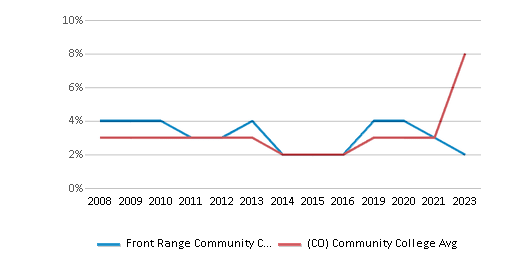- Front Range Community College, the largest community college in Colorado, is a comprehensive, two-year, state-supported community college. Our students are recent high school graduates intending to earn technical certificates or Associate of Applied Science degrees for career. They are young adults intending to earn associate degrees and transfer to four-year schools. They are adult learners with career changes in mind. They are students of all ages pursuing their special interests. And they are the employees of business and industry, learning new skills.
School Highlights
Front Range Community College serves 28,805 students (17% of students are full-time).
The college's student:teacher ratio of 29:1 is higher than the state community college average of 23:1.
Minority enrollment is 40% of the student body (majority Hispanic), which is less than the state average of 51%.
Quick Stats (2025)
- Enrollment: 28,805 students
- In-state tuition: $3,365
- Out-state tuition: $12,693
- Student:teacher ratio: 29:1
- Minority enrollment: 40%
- Source: Integrated Postsecondary Education Data System (IPEDS)
Top Rankings
Front Range Community College ranks among the top 20% of public schools in Colorado for:
School Overview
The teacher population of 983 teachers has stayed relatively flat over five years.
Front Range Community College
(CO) Community College Avg.
Carnegie Classification
Associate's Colleges: Mixed Transfer/Career & Technical-High Nontraditional
Not applicable, not in Carnegie universe (not accredited or nondegree-granting)
Institution Level
Four or more years
At least 2 but less than 4 years
Institution Control
Public
Private, for profit
Total Faculty
983 staff
80 staff

School Calendar
Student Body
The student population of Front Range Community College has grown by 49% over five years.
The student:teacher ratio of 29:1 has increased from 19:1 over five years.
The Front Range Community College diversity score of 0.58 is less than the state average of 0.69. The school's diversity has stayed relatively flat over five years.
Total Enrollment
28,805 students
1,174 students

Student : Teacher Ratio
29:1
23:1

# Full-Time Students
5,033 students
712 students

# Part-Time Students
23,772 students
1,500 students



# Enrollment Undergraduate
288 students
185 students
# Full-Time Undergraduate Students
5,033 students
483 students

# Full-Time Graduate Students
n/a
95 students
# Part-Time Undergraduate Students
23,772 students
1,114 students
# Part-Time Graduate Students
n/a
1 students
Total Dormitory Capacity
n/a
346 students
% American Indian/Alaskan
1%
1%

% Asian
4%
6%

% Hispanic
24%
25%

% Black
2%
6%

% White
60%
49%

% Hawaiian
n/a
3%

% Two or more races
4%
4%

% Non Resident races
2%
2%

% Unknown races
4%
4%


Diversity Score
0.58
0.69

College Completion Rate (Students who graduate in less than 4 years)
26%
46.42%

College Completion Rate (Students who graduate in 4 years or more than 4 years)
0.2712%
0.2712%
Average Graduate Earnings (10 Years)
$38,000
$33,300

Tuition and Acceptance Rate
The public in-state tuition of $3,365 is less than the state average of $3,735. The in-state tuition has declined by 16% over four years.
The public out-state tuition of $12,693 is more than the state average of $10,403. The out-state tuition has declined by 17% over four years.
In-State Tuition Fees
$3,365
$3,735

Out-State Tuition Fees
$12,693
$10,403

% Students Receiving Some Financial Aid
51%
84%

Median Debt for Graduates
$13,000
$11,000

Median Debt for Dropouts
$5,500
$5,500

Acceptance Rate
n/a
98%
Source: 2024 (or latest year available) Integrated Postsecondary Education Data System (IPEDS) , School Administrators
School Notes
- Our curriculum prepares vocational, academic, and business-oriented students to succeed in a highly competitive, global economy by focusing on quality, innovation, technology, self initiative, and problem solving. Located near the crossroads of Adams, Boulder, Broomfield, and Jefferson counties at the start of the U.S. 36 technology corridor, FRCC-Westminster blends up-to-date technology with an old-fashioned commitment to personal attention and small class size. The area is a prime target for industry expansion and relocation. Students may choose from about a hundred career/technical certificates, degrees, and degree emphases. The Nursing and Interpreter Preparation programs have received Programs of Excellence Awards from the Colorado Commission on Higher Education. The City of Westminster collaborated with FRCC in creating College Hill Library, a joint-use library for college and community alike. The spacious Campus Center serves students as well as community organizations. Front Range Community College is accredited by The Higher Learning Commission, a commission of the North Central Association of Colleges and Schools.
Frequently Asked Questions
How much does Front Range Community College cost?
Front Range Community College's tuition is approximately $3,365 for In-State students and $12,693 for Out-State students.
What is Front Range Community College's ranking?
Front Range Community College ranks among the top 20% of community college in Colorado for: Largest student body and Highest completion rates.
In what neighborhood is Front Range Community College located?
Front Range Community College is located in the North Central Westminster neighborhood of Westminster, CO.
Recent Articles

Obtaining Your Bachelor's Degree at a Community College
Explore the evolving landscape of community colleges offering bachelor's degrees, addressing affordability, accessibility, and workforce needs.

A to Z of Community College Certificates and Courses
From business and healthcare to technology and skilled trades, the article showcases the breadth of options available to students seeking to enhance their knowledge, develop new skills, or pursue career advancement.

What is a Community College?
This comprehensive guide explains what a community college is, its history, and its role in higher education. It covers the types of programs offered, differences from four-year colleges, benefits of attending, and important considerations for prospective students, providing valuable insights for those exploring educational options.









